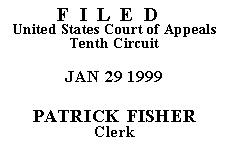

| UNITED STATES OF AMERICA, |
|
On April 12, 1997, defendant and an accomplice broke into a residence on the Navajo Nation Indian Reservation in Shiprock, New Mexico. Upon entering the house, they beat the three occupants, Mike Yazzie, age 65, Mary Woody, age 60, and Janet Ahtcitty, age 37. They also ransacked the house looking for valuables to steal. Finding little of value, Mr. Becenti's accomplice, Tyson Montoya, became frustrated and kicked over a wood stove, sending live embers onto the floor and igniting a house fire. Mr. Becenti and Mr. Montoya fled the burning house along with Ms. Woody and Ms. Ahtcitty. However, Mr. Yazzie could not escape due, in part, to the injuries he sustained from the beating, and he died of smoke inhalation.
On July 2, 1997, a federal grand jury returned a three-count indictment against Mr. Becenti and Mr. Montoya, charging them with first degree felony-murder in violation of 18 U.S.C. § 1111, arson, and burglary. Pursuant to a written plea agreement with the United States, Mr. Becenti pled guilty to a one-count information charging him with second degree murder in violation of 18 U.S.C. § 1111. Prior to sentencing, Mr. Becenti filed a timely objection to the presentence report ("PSR") because it included a two-level increase to his base offense level due to Mr. Yazzie's status as a "vulnerable victim." At the sentencing hearing held on December 12, 1997, the district court overruled Mr. Becenti's objection to the PSR, finding that "[t]he enhancement is proper." Sentencing Hr'g Tr. at 2. This appeal followed.
Mr. Becenti argues that the district court erred when it enhanced his sentence under § 3A1.1(b) of the United States Sentencing Guidelines because it failed to make a sufficient finding of vulnerability. We review the district court's interpretation and application of the Sentencing Guidelines de novo. See, e.g., United States v. Hershberger, 962 F.2d 1548, 1550 (10th Cir. 1992). However, the district court's factual findings underlying a Sentencing Guideline enhancement, including whether a victim is vulnerable for the purposes of § 3A1.1(b), are reviewed under the clearly erroneous standard. See, e.g., United States v. Tissnolthtos, 115 F.3d 759, 761 (10th Cir. 1997); United States v. Brunson, 54 F.3d 673, 676 (10th Cir. 1995). A finding is clearly erroneous only when it is "without factual support in the record, or if after reviewing all the evidence[,] we are left with the definite and firm conviction that a mistake has been made." United States v. Beaulieu, 893 F.2d 1177, 1182 (10th Cir. 1990).
Section 3A1.1(b) provides for a two-level increase in the base offense level when "the defendant knew or should have known that a victim of the offense was unusually vulnerable due to age, physical or mental condition, or that a victim was otherwise particularly susceptible to the criminal conduct." Our case law makes clear that "[i]n order to classify a victim as 'vulnerable,' the sentencing court must make particularized findings of vulnerability. The focus of the inquiry must be on the victim's personal or individual vulnerability." See Brunson, 54 F.3d at 676 (internal citations and quotations omitted).
Defendant argues that because the PSR included a vulnerable victim enhancement based solely upon Mr. Yazzie's age and because the district court adopted the PSR's findings, the court did not make a particularized finding sufficient to sustain the sentence enhancement. We disagree. While it is true that "a victim's elderly status, without more, is insufficient to justify a vulnerable victim enhancement," Tissnolthtos, 115 F.3d at 761; accord United States v. Smith, 930 F.2d 1450, 1455 (10th Cir. 1991), here the district court, contrary to defendant's assertion, did not base the sentence enhancement solely upon the victim's age. In addition to adopting the PSR's findings, the court stated:
The court takes judicial notice that the defendant and co-defendant forcibly entered the home of an elderly couple with the intent to commit a burglary. The defendant ransacked the home, battered the three occupants and caused a fire that consumed the home. The victim, a 65 year old man[,] was unable to get out of the fire and died of carbon monoxide poisoning.
Sentencing Hr'g Tr. at 5. Thus, the district court independently acknowledged that, in addition to his age, Mr. Yazzie had been beaten and was unable to escape the burning house. As noted earlier, a district court's finding of vulnerability for the purpose of § 3A1.1(b) will be upheld unless it is clearly erroneous. Here, the district court's finding of vulnerability is adequately supported by facts in the record, including facts other than the victim's age. Thus, we hold that the district court did not err in enhancing the defendant's sentence two levels pursuant to § 3A1.1(b) of the United States Sentence Guidelines. We therefore AFFIRM the sentence imposed by the district court.
ENTERED FOR THE COURT,
Deanell Reece Tacha
Circuit Judge
*.This order and judgment is not binding precedent, except under the doctrines of law of the case, res judicata, and collateral estoppel. This court generally disfavors the citation of orders and judgments; nevertheless, an order and judgment may be cited under the terms and conditions of 10th Cir. R. 36.3.